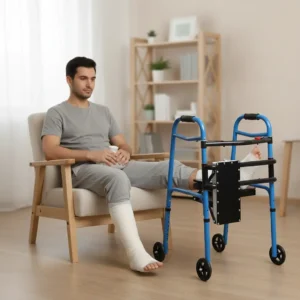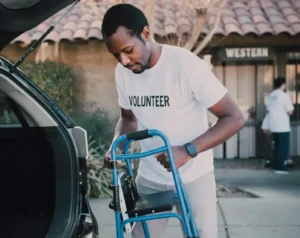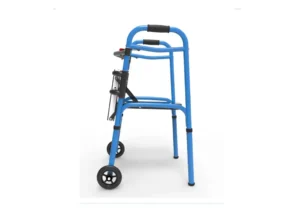Recovering from an ankle injury can be a challenging journey, but the right support can make all the difference. In this blog, we’ll explore the importance of ankle support during recovery, the different types available, and tips for a smoother healing process. Whether you’re an athlete or someone who enjoys an active lifestyle, understanding how to properly support your ankle can help you regain strength and mobility with confidence.
The Role of Ankle Support in Injury Recovery
Ankle support is crucial in managing pain and preventing further injury. It stabilizes the joint, allowing for safer movement and effective healing. Understanding its role can help you approach recovery with the right mindset.
Moreover, proper ankle support can help alleviate stress on surrounding muscles and tissues, creating an environment conducive to recovery. This support not only aids in the physical healing process but also aligns with the mental aspect of healing. When you feel secure in your movements, it can significantly reduce anxiety about re-injury. This blend of physical and emotional support is vital.
As you embark on your recovery journey, remember that the type of ankle support you choose should align with your unique situation. Speak with a healthcare professional who can tailor recommendations based on your needs and progress. They can provide insight into when to increase mobility or when to amp up your support, ensuring that your recovery is both effective and safe.
Types of Ankle Support: Choosing What’s Right for You
There are various types of ankle supports, including braces, wraps, and orthotics. Each serves different purposes and varies in levels of support. Exploring these options will help you find what suits your needs best.
Ankle braces, for example, provide rigid stabilization, which can be beneficial immediately after an injury. These braces limit movement effectively while allowing some level of blood circulation. This is crucial as it promotes healing while protecting the joint. On the other hand, elastic wraps offer more flexibility, allowing mild support during daily activities, and can be a great choice during the later stages of recovery when mobility is needed.
And let’s not forget about orthotic devices. These specialized supports can correct existing imbalances and ensure that your foot and ankle work in harmony. By addressing underlying structural issues, orthotics can maximize your recovery and prevent future injuries. Take some time to evaluate which type works best for your lifestyle and the stage of recovery you’re in.
When to Use Ankle Support During Recovery
Knowing when to use ankle support is essential. Depending on your injury’s severity and phase of recovery, the frequency and type of support needed may change. We’ll discuss signs that indicate when to rely on support and when to begin tapering off.
In the initial stages post-injury, using support around the clock is often recommended to keep the joint stable. As healing progresses, you may find that you can gradually reduce your reliance on these supports. A common guideline is to listen to your body: if you feel discomfort or instability, it might be time to reintroduce support.
Additionally, it’s important to understand that not every day will feel the same. Some days might require more support than others based on your activities or levels of swelling. Being aware of your body’s signals can guide your use of support. By monitoring how you feel and making adjustments accordingly, you can optimize your recovery process.
The Benefits of Physical Therapy and Ankle Support
Physical therapy can complement the use of ankle support. Together, they can enhance your recovery, improve strength, and restore mobility. We’ll highlight how to work alongside a therapist for the best outcomes.
A physical therapist can teach you specific exercises aimed at strengthening the ankle once the immediate pain subsides. These exercises, combined with appropriate ankle support, can significantly enhance your stability and flexibility. Often, the professional guidance you receive will ensure that you’re not just moving, but moving safely and effectively.
Furthermore, therapists will monitor your progress and assess how well your ankle is responding to treatment. This partnership can adjust your support as your healing improves, ensuring that you’re always equipped with the right tools for the level of activity you engage in. Having this dual approach provides not just physical rehabilitation but also educational empowerment on how to care for your ankle long-term.
Preventing Future Injuries: Strengthening and Support
Once recovery is underway, focusing on preventive measures is vital. We’ll explore exercises to strengthen your ankle and how ongoing support can play a role in long-term joint health.
Incorporating strengthening exercises into your routine can be game-changing. These exercises help develop the muscles around your ankle, creating a robust support system that reduces the risk of re-injury. Activities like balance training or resistance exercises can go a long way. Additionally, always remember to gradually increase intensity and duration to avoid overloading your healing tissues.
Furthermore, don’t underestimate the importance of good practices like proper footwear. Choosing shoes that provide adequate support and cushioning will significantly decrease the chances of rolling your ankle or facing other injuries. This multifaceted approach—combining strength training, proper support, and being mindful of footwear—will shape a healthier, more resilient ankle in the long run.
Embrace Your Recovery Journey
With the right knowledge and tools, navigating your recovery journey can be a less daunting task. Remember, ankle support is not just about stabilizing your injury; it’s about fostering a positive environment for healing. From understanding your options to implementing supportive practices in your daily routine, you can take proactive steps towards recovery. Listen to your body, be patient, and embrace the support that is available to you as you move forward.




